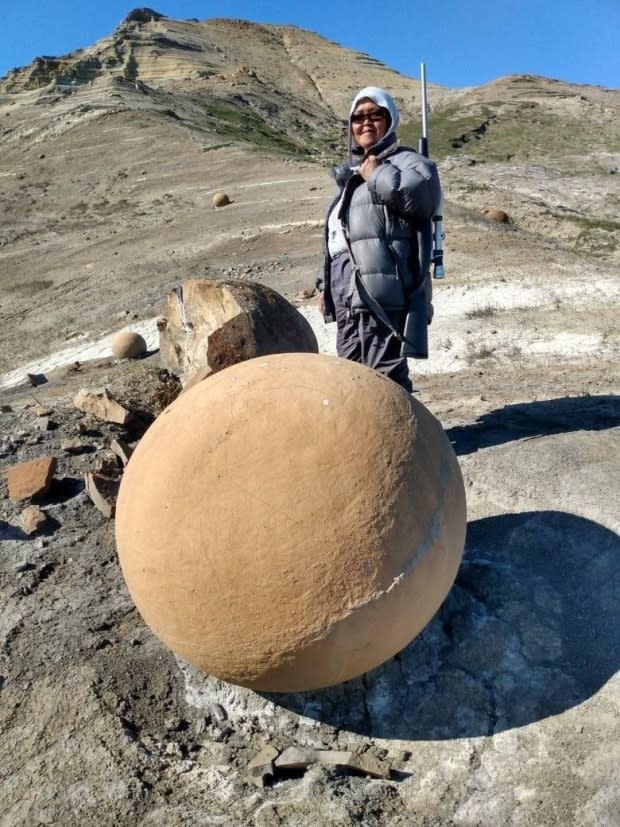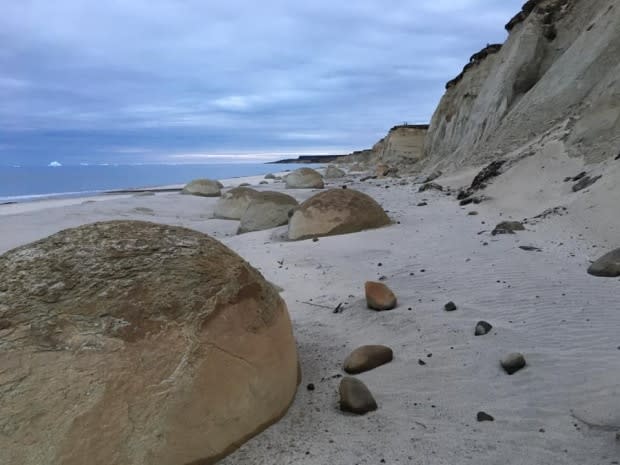How these weird round rocks came to be on Canada's Arctic shoreline
They're perfectly round and hard as, well, rock — and they're littering Canada's Arctic shore.
Eerily round rocks can be found on beaches from Paulatuk, N.W.T., to Coral Harbour, Nunavut, but they still inspire awe in many who are seeing these strange stones for the first time.
Social media erupted with wonder when Bethuel Ootoovak posted a photo of Ida Pikuyak posing next to one near Pond Inlet, Nunavut.
Some thought they might be meteors descended from space or giant dinosaur eggs petrified over millennia. Some even saw the handiwork of an alien race.
It's not the first time people have thought these strange stones to be the work of aliens, gods, or giants. But in fact there is a natural explanation.
The uncannily round stones found in Pond Inlet are an example of fairly common phenomena called concretions.

The process begins with a pile of sediment — mud, silt, or sand — near a flowing body of water, explained Marc St-Onge, a researcher with the Geological Survey of Canada.
Over time, harder materials, like shells, leaves and fossils, will be carried into the pile by that flowing water.
In most places, that pile of sediment remains just that — a pile. But if there's some "cementing mineral" dissolved in the sediment, he said — something like calcite, the mineral that forms limestone — those tiny leaves and shells will become the seed for giant rocks like the ones at Pond Inlet.
![Lisa Redfern [CC-BY-SA 3.0]](https://s.yimg.com/ny/api/res/1.2/286vfT_0FDeN.33StlKzKg--/YXBwaWQ9aGlnaGxhbmRlcjt3PTk2MA--/https://media.zenfs.com/en/cbc.ca/c28356d1a0d251780550d890605ae7fd)
Over millennia, layers of hard, concrete-like rock form around the object, like an ancient stone onion.
Any sediment that forms on the onion is a lot softer, St-Onge said, so it erodes more easily — though it would still take waves or ice millions of years to form the perfect spheres at Pond Inlet. He estimates the concretions in Pond Inlet are about 100 million years old.
Even though the process behind a concretion is epically long and quite specific, they're more common than you might think.

As commenters on Ootoovak's photos learned, they're found all over the north, from Kodiak Island on Alaska's southern coast to Paulatuk in the Northwest Territories and Qeqertarsuaq in Greenland.
In fact, concretions can even be found in places far from water, like Alberta's Red Rock Coulee or Kazakhstan's Valley of the Balls.
That doesn't make Pond Inlet's massive rocky spheres any less amazing, though — Ootoovak's photos were shared more than 1,700 times on Facebook.

